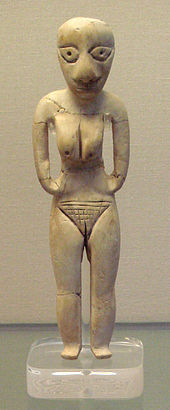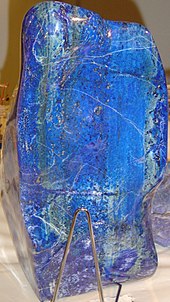41st century BC Chr.
Portal history | Portal Biographies | Current events | Annual calendar
◄ |
6th mill. Chr. |
5th millennium BC Chr. | 4th mill. Chr. ►
◄ |
43rd century BC Chr. |
42nd century BC Chr. |
41st century BC Chr. |
40th century BC Chr. |
39th century BC Chr. |
►
The 41st century BC Chr. Began on January 1 v 4100th And ended on December 31, 4001 BC. This corresponds to the period 6050 to 5951 BP or the interval 5269 to 5192 radiocarbon years .
Time calculation
- 4026 BC Chr .:
- Creation of Adam for Jehovah's Witnesses .
- 4004 BC Chr .:
- According to the Ussher-Lightfoot calendar, the creation of the universe took place on Saturday October 22nd at nightfall ( Julian calendar ). In the Gregorian calendar this corresponds to September 20, 4003 BC. The calculations made by James Ussher are based on the Old Testament .
Age / Epoch
- Late Atlantean (AT3), transition from lower level I (4550 to 4050 BC) to lower level II (4050 to 3710 BC), with water levels rising again.
- Early Neolithic in Central Europe .
Developments, inventions and discoveries
- Cultivation of sorghum and rice in Sudan .
- First diving in Egypt around 4000 BC Nails made of copper .
- First urban dwellings in Ur and Uruk (Sumer) as well as in Tell Hamoukar ( Syria ).
- Development of the loom in Iraq .
- In Ur is lapis lazuli introduced.
Events
- Around 4000 BC Chr .:
- Rehman Dheri founded the first fortified city on the Indian subcontinent .
- In the cave of Baume de Fontbrégoua in the Var department in France, there is evidence of cannibalism .
Archaeological cultures

Woman statuette made of hippopotamus ivory, Badari culture , approx. 4000 BC Chr.

Gui of the Dawenkou culture
Cultures in North Africa
- Tenerife (5200 to 2500 BC) in the Ténéré desert with Gobero site .
Cultures in Egypt
- The Badari culture (4400-4000 BC) disappears at the end of the 41st century
- The heyday of the Naqada culture in Upper Egypt (Naqada I - 4500 to 3500 BC)
Cultures in Mesopotamia and the Middle East
- Sumer : Transitional phase from the Obed period (LC-1 or Uruk XVI to Uruk XIV) to the early Uruk period (early LC-2 or Uruk XII).
- Obed culture in Mesopotamia (5500 to about 3500 BC) - Obed III
- Uruk period (from 4000 to 3100/3000 BC), with a transition phase from 4200 BC Chr.
- Nineveh (from 6500 BC) in northern Mesopotamia - Nineveh 3
- Tappe Sialk (6000 to 2500 BC) in Iran - Sialk III
- Amuq (6000 to 2900 BC) in Turkey - Amuq E.
- Mersin (5400 to 2900 BC) in Anatolia - Mersin 24-15
- Eridu (from 5300 to approx. 1950 BC) in Mesopotamia - Eridu 19-9
- Tappa Gaura (5000 to 1500 BC) in northern Mesopotamia - Tappa Gaura 20-12 or XI to Xa
- Susa (from 4000 BC) in Iran - Susa I
- Tell Hammam et-Turkman in Syria - Va / Vb
Cultures in East Asia
-
China :
- Dadiwan culture (5800-3000 BC), upper Yellow River
- Yangshao culture (5000 to 2000 BC), central and northern China
- Hongshan Culture (4700-2900 BC), Northeast China
- Daxi culture (4400 to 3300 BC), middle Yangtze River
- Beginning of the Dawenkou culture (4100 to 2600 BC), along the Yellow Sea .
-
Korea :
- Early Jeulmun period (6000 to 3500 BC).
-
Japan :
- Jōmon period (10,000 to 300 BC) - the earliest Jōmon period - Jōmon II (8,000 to 4,000 BC) - is coming to an end.
Cultures in Europe
-
Northeast Europe :
- Neman culture (7000 to 3000 BC) in Poland , Lithuania and Belarus
- Pit ceramic culture (4200 to 2000 BC - radiocarbon dating : 5600 to 2300 BC)
- Narva culture (5300 to 1750 BC) in Estonia , Latvia, and Lithuania
-
Eastern Europe :
- Kurgan cultures (5000 to 3000 BC) in Kazakhstan and Eastern Europe ( Russia , Ukraine )
-
Southeast Europe :
- Cucuteni Culture (4800 to 3200 BC): Early Phase A / B (4200 to 4000 BC)
- Gumelniţa culture (4700 to 3700 BC): phase Gumelniţa A2 (4500 to 3950 BC)
- The Varna culture (4400 to 4100 BC) in Bulgaria disappears at the beginning of the century.
- Boian culture in Romania and Bulgaria (4300 to 3500 BC) - Phase III - Vidra phase, 4100-4000 BC Chr.
-
Central Europe ( Early Neolithic - 4400 to 3500 BC):
- Lengyel culture (4900 to 3950 BC) in Hungary , Austria and the Czech Republic
- Tiszapolgár culture (4500 to 4000 BC) in Hungary and Slovakia
- Rössen culture - 4500/4300 to 3500 BC In East Germany
- Gatersleben culture - 4300 to 3900 BC In East Germany
- Jordansmühler culture (4300 to 3900 BC) in eastern Central Europe
- Aichbühler Group (4200 to 4000 BC) in southern Germany
- Schussenrieder Group (4200 to 3700 BC) in southwest Germany
- Baalberg culture (4200 to 3100 BC) in central Germany
- Funnel beaker culture (4200 to 2800 BC) in northern Central Europe
-
Western Europe :
- Chassey-Lagozza-Cortaillod culture (4600 to 2400 BC) in France , Switzerland and Italy
-
Megalithic cultures :
- France (4700 to 2000 BC)
- Malta : Beginning of the Żebbuġ phase (4100-3800 BC) with the Brochtorff Circle
-
North and Mesoamerica :
- Archaic period .
- Coxcatlán phase (5000–3400 BC) in Tehuacán ( Mexico )
-
South America :
- Chinchorro culture (7020 to 1500 BC) in northern Chile and southern Peru.
- Middle Pre-Ceramic (7000 to 4000 BC) in northern Chile . Lower Alto Barranco and Alto Aguada along the Pacific coast and Rinconada in the hinterland.
Individual evidence
- ↑ https://wol.jw.org/de/wol/d/r10/lp-x/1200000089
- ^ Roberts, J .: History of the World . Penguin, 1994.
- ↑ M. Voigt, RH Dyson: The Chronology of Iran, approx. 8000-2000 BC , In: RW Ehrich (editor): Chronologies in Old World Archeology , Chicago / London, pp. 122-178, especially Table 2
